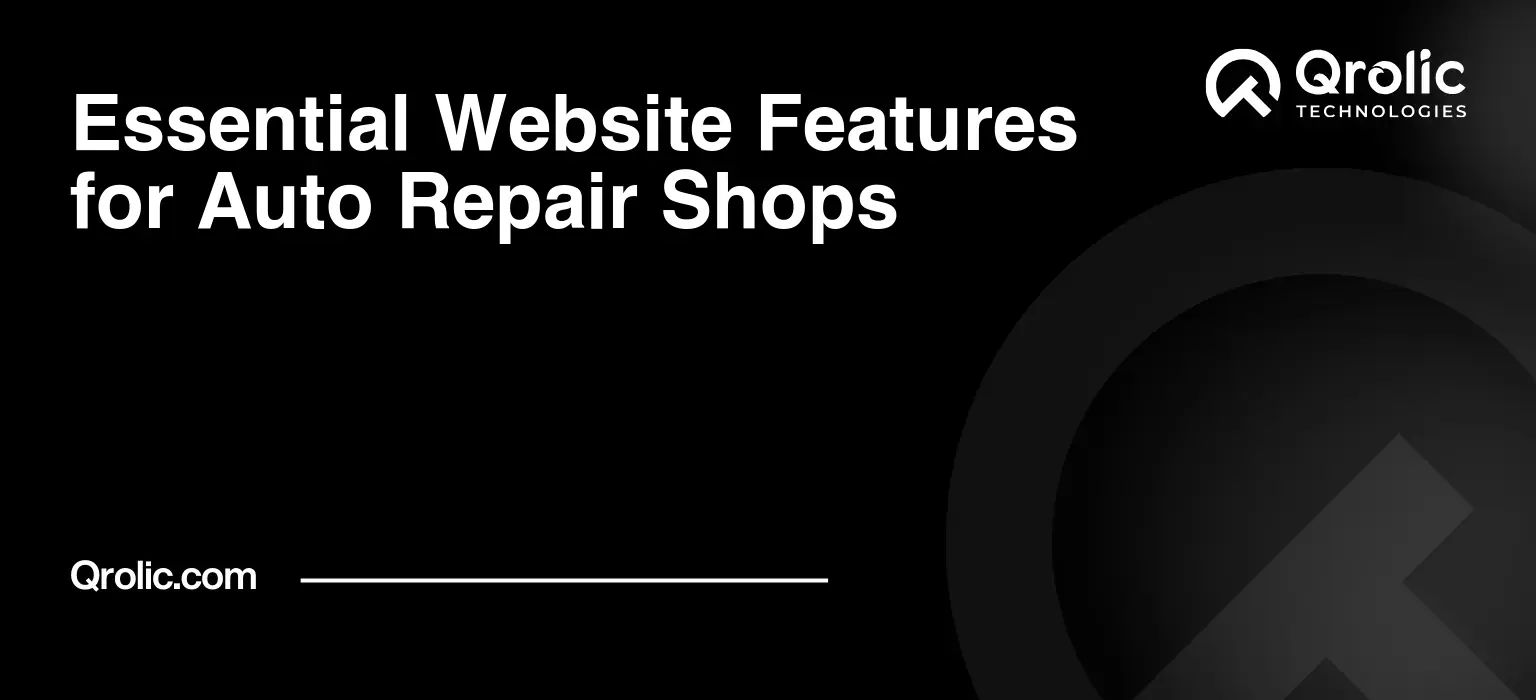Your auto repair shop is the heart of your community, keeping vehicles running smoothly and safely. But in today’s digital world, a physical location isn’t enough. You need a powerful online presence, starting with a website that attracts customers, builds trust, and streamlines your business. This isn’t just about having a website; it’s about having a website that works for you. Let’s dive into the essential features that transform your website from a digital brochure into a customer-generating machine.
Quick Summary:
- Make your website mobile-friendly and fast.
- Offer easy online booking and clear service details.
- Build trust with customer reviews and helpful content.
Table of Contents
- 1. Responsive and Mobile-Friendly Design: The Foundation of User Experience
- Why Mobile-First Matters: Reaching Customers Where They Are
- Beyond Mobile: A Consistent Experience on All Devices
- 2. Online Service Scheduling: Convenience at Your Customers’ Fingertips
- The Power of Self-Service: Empowering Your Customers
- Key Features of an Effective Online Scheduling System
- Choosing the Right Scheduling Software
- 3. Customer Testimonials and Reviews: Building Trust and Credibility
- Social Proof: The Power of Word-of-Mouth Marketing
- Strategies for Collecting Testimonials and Reviews
- How to Effectively Display Testimonials on Your Website
- Responding to Negative Reviews: Turning Negatives into Positives
- 4. Detailed Service Descriptions and Pricing: Transparency Builds Confidence
- Informative Content: Educating Your Customers
- Transparent Pricing: Avoiding Surprises
- 5. High-Quality Images and Videos: Visual Storytelling
- Show, Don’t Just Tell: Engaging Visuals
- Video Marketing: Captivating Your Audience
- 6. Blog and Educational Resources: Establishing Authority and Expertise
- Content is King: Attracting and Engaging Your Audience
- Writing Effective Blog Posts
- 7. Contact Information and Location Map: Making it Easy to Connect
- Accessibility is Key: Connecting with Your Customers
- Interactive Map: Guiding Customers to Your Door
- 8. Security Features: Protecting Customer Data
- Trust and Security: A Non-Negotiable
- 9. Fast Loading Speed: Keeping Customers Engaged
- The Need for Speed: Optimizing for Performance
- 10. Search Engine Optimization (SEO): Getting Found Online
- Climbing the Ranks: Mastering SEO Fundamentals
- Let Qrolic Technologies Help You Build the Perfect Website
1. Responsive and Mobile-Friendly Design: The Foundation of User Experience
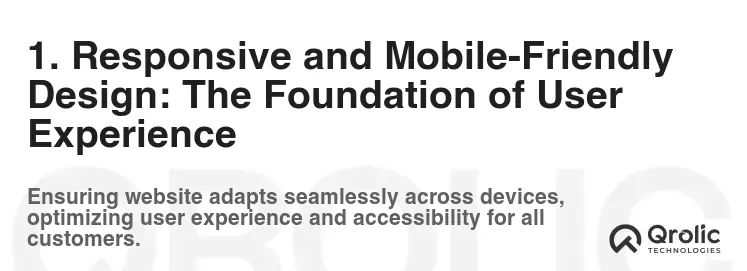
Why Mobile-First Matters: Reaching Customers Where They Are
Think about how people find auto repair shops. Often, it’s in a moment of need – a flat tire on the side of the road, a strange noise under the hood, or a sudden warning light. They’re reaching for their phones, not their desktops. If your website isn’t optimized for mobile devices, you’re losing potential customers before they even see what you offer.
Statistics:
- Over 60% of searches for local businesses happen on mobile devices.
- Google prioritizes mobile-friendly websites in search rankings.
- A bad mobile experience can lead to a 57% abandonment rate.
What Makes a Website Mobile-Friendly?
- Responsive Design: The website automatically adjusts to fit any screen size, from smartphones to tablets to desktops.
- Fast Loading Speed: Mobile users are impatient. Optimize images, minimize code, and leverage browser caching to ensure quick loading times.
- Easy Navigation: Menus should be clear and intuitive, with large enough buttons and links for easy tapping.
- Readable Text: Use a legible font size and contrast ratio for comfortable reading on smaller screens.
- Touch-Friendly Forms: Make form fields large enough to tap easily, and minimize the number of fields required.
Example:
Imagine a customer stranded with a dead battery. They Google “auto repair near me” on their phone. They click on your website, but it’s slow to load, the text is tiny, and the navigation is clunky. Frustrated, they hit the back button and choose your competitor. A responsive, mobile-friendly website ensures this scenario never happens.
Beyond Mobile: A Consistent Experience on All Devices
While mobile is critical, your website should also provide a seamless experience on tablets and desktops. This means:
- Consistent Branding: Maintain a consistent look and feel across all devices to reinforce your brand identity.
- Optimal Layouts: Ensure the layout adapts well to different screen sizes, avoiding awkward spacing or overlapping elements.
- Full Functionality: All features, including service scheduling, contact forms, and blog posts, should be fully functional on all devices.
How to Test Your Website’s Responsiveness:
- Google’s Mobile-Friendly Test: A free tool that analyzes your website’s mobile-friendliness.
- Responsive Design Checker: Online tools that simulate how your website looks on different devices.
- Manual Testing: View your website on various smartphones, tablets, and desktops to identify any issues.
2. Online Service Scheduling: Convenience at Your Customers’ Fingertips
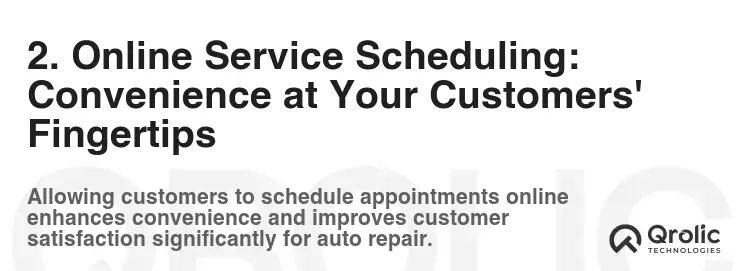
The Power of Self-Service: Empowering Your Customers
In today’s busy world, customers value convenience. Offering online service scheduling empowers them to book appointments at their own pace, anytime, anywhere. This not only enhances customer satisfaction but also streamlines your operations.
Benefits of Online Service Scheduling:
- Increased Bookings: 24/7 availability makes it easier for customers to book appointments, even outside of business hours.
- Reduced Phone Calls: Automate the booking process and free up your staff to focus on other tasks.
- Improved Customer Satisfaction: Provide a convenient and hassle-free booking experience.
- Reduced No-Shows: Send automated reminders to customers before their appointments.
- Better Data Collection: Gather valuable data on appointment trends and customer preferences.
Key Features of an Effective Online Scheduling System
- Real-Time Availability: Display your shop’s availability in real-time, preventing double bookings.
- Service Selection: Allow customers to choose from a list of services, such as oil changes, tire rotations, and brake repairs.
- Vehicle Information: Capture vehicle information, such as make, model, and year, to prepare for the appointment.
- Date and Time Selection: Provide a calendar interface for customers to choose their preferred date and time.
- Appointment Confirmation: Send automated email or SMS confirmations to customers after they book an appointment.
- Appointment Reminders: Send automated reminders leading up to the appointment to reduce no-shows.
- Integration with Shop Management Software: Seamlessly integrate with your shop management software to streamline workflow.
Example:
A customer needs an oil change. Instead of calling your shop during their lunch break, they can simply visit your website, select “oil change,” choose their vehicle make and model, pick a convenient date and time, and receive an instant confirmation. This convenience translates to happy customers and more bookings for your shop.
Choosing the Right Scheduling Software
Numerous online scheduling software options are available, each with its own set of features and pricing. Consider the following factors when choosing a solution:
- Ease of Use: The software should be intuitive and easy to use for both your staff and your customers.
- Features: Choose a solution that offers the features you need, such as real-time availability, service selection, and appointment reminders.
- Integration: Ensure the software integrates seamlessly with your existing shop management software.
- Pricing: Compare pricing plans from different providers and choose one that fits your budget.
- Customer Support: Look for a provider with responsive and helpful customer support.
3. Customer Testimonials and Reviews: Building Trust and Credibility

Social Proof: The Power of Word-of-Mouth Marketing
In today’s digital age, online reviews are the new word-of-mouth marketing. Customers trust the opinions of other customers, often more than they trust advertising. Displaying customer testimonials and reviews on your website is a powerful way to build trust and credibility.
Why Testimonials and Reviews Matter:
- Build Trust: Positive reviews demonstrate that you provide quality service and care about your customers.
- Increase Conversions: Customers are more likely to book an appointment if they see positive reviews from other customers.
- Improve SEO: Google considers reviews when ranking websites, so positive reviews can improve your search engine rankings.
- Provide Valuable Feedback: Reviews can provide valuable feedback on your services and identify areas for improvement.
Strategies for Collecting Testimonials and Reviews
- Ask for Reviews: Simply ask satisfied customers to leave a review on your website, Google, Yelp, or other review platforms.
- Automated Emails: Send automated emails after service appointments asking customers to leave a review.
- Incentivize Reviews: Offer a small incentive, such as a discount on their next service, for leaving a review.
- Make it Easy: Provide direct links to your review profiles on your website and in your email communications.
- Monitor Your Reviews: Regularly monitor your reviews on various platforms and respond to both positive and negative feedback.
How to Effectively Display Testimonials on Your Website
- Prominent Placement: Display testimonials prominently on your homepage, service pages, and about us page.
- Authenticity: Use real customer names and photos (with permission) to enhance authenticity.
- Variety: Showcase a variety of testimonials that highlight different aspects of your service.
- Visual Appeal: Use visually appealing formatting, such as quotes, images, and star ratings, to make testimonials stand out.
- Filter and Curate: Filter out fake or irrelevant reviews and curate the best testimonials to showcase your strengths.
Example:
Imagine a customer searching for a reliable auto repair shop. They land on your website and see a collection of glowing testimonials from satisfied customers praising your honesty, expertise, and friendly service. This social proof instantly builds trust and makes them more likely to choose your shop.
Responding to Negative Reviews: Turning Negatives into Positives
Negative reviews are inevitable, but how you respond to them can make all the difference. Acknowledge the customer’s concern, apologize for their experience, and offer a solution. This demonstrates that you care about your customers and are committed to resolving issues.
Key Principles for Responding to Negative Reviews:
- Respond Promptly: Address negative reviews as quickly as possible.
- Be Professional: Maintain a professional and courteous tone, even if the review is unfair or inaccurate.
- Acknowledge the Issue: Acknowledge the customer’s concern and show that you understand their frustration.
- Offer a Solution: Offer a solution to the problem, such as a refund, a discount, or a free service.
- Take it Offline: Invite the customer to contact you directly to discuss the issue further.
- Learn from Feedback: Use negative reviews as an opportunity to identify areas for improvement in your business.
4. Detailed Service Descriptions and Pricing: Transparency Builds Confidence
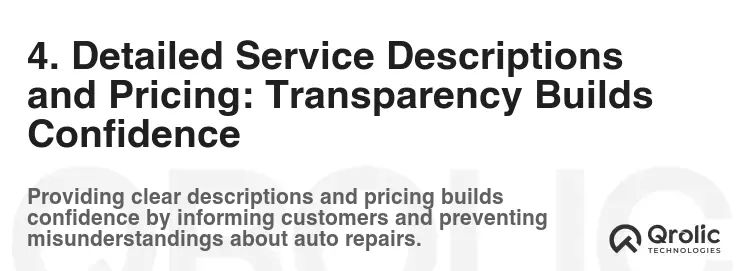
Informative Content: Educating Your Customers
Customers want to know what services you offer and how much they cost. Providing detailed service descriptions and transparent pricing on your website builds confidence and reduces the likelihood of misunderstandings.
What to Include in Service Descriptions:
- Clear and Concise Language: Use clear and concise language that is easy for customers to understand.
- Benefits: Focus on the benefits of the service, such as improved performance, increased safety, or extended vehicle life.
- Process: Briefly explain the process involved in the service.
- Parts and Materials: List the parts and materials used in the service.
- Warranty Information: Provide information on any warranties offered on the service.
Example:
Instead of simply listing “Brake Repair,” provide a detailed description that explains the different types of brake repair, the signs that indicate a need for brake repair, and the benefits of getting your brakes repaired by your shop.
Transparent Pricing: Avoiding Surprises
Customers appreciate knowing the cost of services upfront. While it may not be possible to provide exact prices for all services, you can provide price ranges or starting prices.
Strategies for Providing Transparent Pricing:
- Price Ranges: Provide price ranges for common services, such as oil changes and tire rotations.
- Starting Prices: List starting prices for more complex services, such as engine repairs and transmission replacements.
- Online Estimators: Offer online estimators that allow customers to get a rough estimate of the cost of a service based on their vehicle information.
- Disclaimers: Include disclaimers that explain that prices may vary depending on the specific situation.
- Quote Requests: Allow customers to request a quote for specific services.
Why Transparency Matters:
- Builds Trust: Customers are more likely to trust a shop that is upfront about its pricing.
- Reduces Surprises: Eliminates the risk of surprising customers with unexpected costs.
- Attracts Price-Sensitive Customers: Attracts customers who are looking for the best value.
- Reduces Price Negotiations: Reduces the need for price negotiations.
5. High-Quality Images and Videos: Visual Storytelling

Show, Don’t Just Tell: Engaging Visuals
High-quality images and videos can bring your website to life and engage your customers. Visuals can showcase your shop’s expertise, equipment, and customer service.
Types of Visual Content to Include:
- Shop Photos: Photos of your shop’s interior and exterior.
- Team Photos: Photos of your technicians and staff.
- Service Photos: Photos of your technicians performing various services.
- Before-and-After Photos: Photos that show the results of your work.
- Customer Testimonial Videos: Videos of satisfied customers sharing their experiences.
- Educational Videos: Videos that explain common auto repair issues and solutions.
Tips for Creating High-Quality Visual Content:
- Use Professional Equipment: Invest in a good quality camera or hire a professional photographer or videographer.
- Good Lighting: Ensure good lighting to capture clear and vibrant images and videos.
- Clean and Organized: Keep your shop clean and organized when taking photos and videos.
- Authenticity: Showcase your shop’s personality and culture in your visuals.
- Optimize for Web: Optimize images and videos for web use to ensure fast loading times.
Example:
A customer is deciding between two auto repair shops. One website has generic stock photos, while the other features real photos of the shop, its technicians, and examples of their work. The second website is more likely to win the customer’s business because it feels more authentic and trustworthy.
Video Marketing: Captivating Your Audience
Video marketing is a powerful way to connect with your audience and promote your services. Create videos that educate, entertain, and inspire your customers.
Video Ideas for Auto Repair Shops:
- “Meet the Team” Videos: Introduce your technicians and staff to build trust and rapport.
- “How-To” Videos: Provide helpful tips and advice on common auto repair issues.
- “Behind-the-Scenes” Videos: Show customers what goes on behind the scenes at your shop.
- “Customer Testimonial” Videos: Feature satisfied customers sharing their experiences.
- “Service Spotlight” Videos: Highlight specific services and explain their benefits.
6. Blog and Educational Resources: Establishing Authority and Expertise
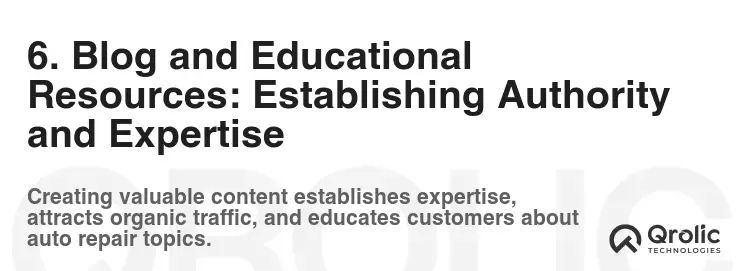
Content is King: Attracting and Engaging Your Audience
Creating a blog and providing educational resources on your website establishes you as an authority in the auto repair industry and attracts potential customers.
Benefits of Blogging:
- Improved SEO: Regularly publishing fresh, relevant content improves your website’s search engine rankings.
- Increased Traffic: Blog posts can attract visitors to your website through search engines and social media.
- Lead Generation: Blog posts can generate leads by providing valuable information and offering a call to action.
- Customer Education: Blog posts can educate customers about common auto repair issues and solutions.
- Brand Building: Blogging helps build your brand and establish you as an authority in the industry.
Blog Post Ideas for Auto Repair Shops:
- “Common Car Problems and How to Fix Them”
- “Tips for Maintaining Your Vehicle”
- “Seasonal Car Care Checklist”
- “Understanding Your Car’s Warning Lights”
- “Choosing the Right Tires for Your Vehicle”
- “The Importance of Regular Oil Changes”
- “How to Prepare Your Car for a Road Trip”
Writing Effective Blog Posts
- Choose Relevant Topics: Focus on topics that are relevant to your target audience and their interests.
- Use Clear and Concise Language: Write in a clear and concise style that is easy for customers to understand.
- Optimize for SEO: Use relevant keywords in your titles, headings, and body text.
- Include Images and Videos: Enhance your blog posts with images and videos to make them more engaging.
- Promote Your Blog: Share your blog posts on social media and email newsletters.
7. Contact Information and Location Map: Making it Easy to Connect
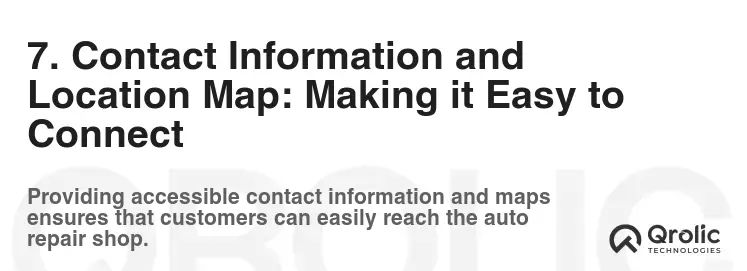
Accessibility is Key: Connecting with Your Customers
Make it easy for customers to contact you by prominently displaying your contact information and location map on your website.
Essential Contact Information to Include:
- Phone Number: Display your phone number in a prominent location, such as the header or footer of your website.
- Email Address: Provide an email address for customers to send inquiries.
- Physical Address: Display your physical address and include a link to a map.
- Business Hours: Clearly state your business hours.
- Contact Form: Include a contact form for customers to submit inquiries directly through your website.
Why This Information Matters:
- Customer Convenience: Makes it easy for customers to contact you when they need assistance.
- Local SEO: Helps Google understand your location and display your website in local search results.
- Trust and Credibility: Shows that you are a legitimate business with a physical presence.
Interactive Map: Guiding Customers to Your Door
Embed an interactive map on your website to help customers find your shop easily. Google Maps is a popular option that allows customers to get directions directly from your website.
Benefits of Using an Interactive Map:
- Easy Navigation: Provides customers with clear and easy-to-follow directions to your shop.
- Mobile-Friendly: Works seamlessly on mobile devices, allowing customers to find your shop on the go.
- Enhanced User Experience: Improves the user experience by providing a helpful and informative tool.
8. Security Features: Protecting Customer Data
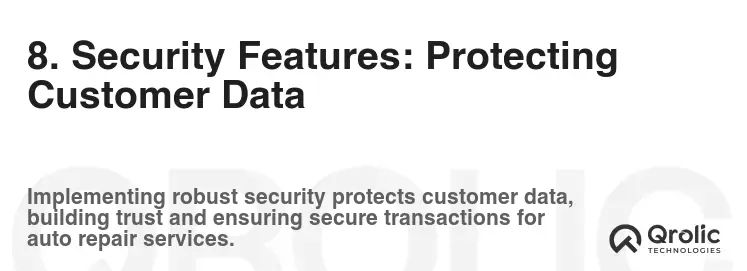
Trust and Security: A Non-Negotiable
In today’s digital landscape, security is paramount. Protect your customers’ data by implementing essential security features on your website.
Essential Security Features to Implement:
- SSL Certificate: Install an SSL certificate to encrypt data transmitted between your website and your customers’ browsers. This protects sensitive information, such as credit card numbers and personal details.
- Website Firewall: Implement a website firewall to protect your website from malicious attacks, such as hacking and malware.
- Regular Backups: Regularly back up your website to prevent data loss in case of a server crash or security breach.
- Strong Passwords: Use strong passwords for all your website accounts and change them regularly.
- Software Updates: Keep your website software, including your content management system (CMS) and plugins, up to date with the latest security patches.
Why Security Matters:
- Customer Trust: Builds trust with your customers by demonstrating that you take their security seriously.
- Data Protection: Protects sensitive customer data from theft or misuse.
- Reputation Management: Prevents damage to your reputation caused by security breaches.
- Compliance: Helps you comply with data privacy regulations, such as GDPR and CCPA.
9. Fast Loading Speed: Keeping Customers Engaged
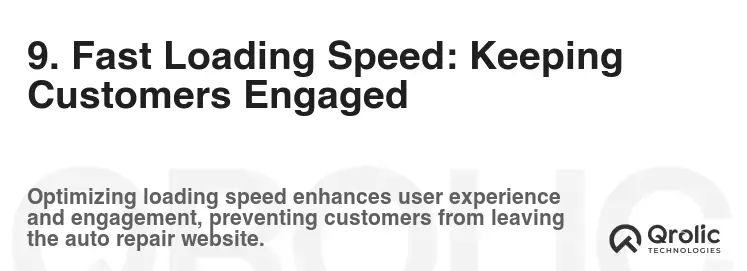
The Need for Speed: Optimizing for Performance
Website loading speed is a critical factor in user experience and SEO. Customers are impatient and will quickly abandon a website that takes too long to load.
Factors that Affect Website Loading Speed:
- Image Size: Large images can significantly slow down your website. Optimize images for web use by reducing their file size without sacrificing quality.
- Code Optimization: Minimize and compress your website’s code (HTML, CSS, and JavaScript) to reduce its size.
- Caching: Leverage browser caching to store static assets, such as images and CSS files, on users’ computers so they don’t have to be downloaded every time they visit your website.
- Content Delivery Network (CDN): Use a CDN to distribute your website’s content across multiple servers around the world, ensuring that it loads quickly for users regardless of their location.
- Hosting Provider: Choose a reliable hosting provider with fast servers and ample bandwidth.
Tools for Testing Website Loading Speed:
- Google PageSpeed Insights: A free tool that analyzes your website’s loading speed and provides recommendations for improvement.
- GTmetrix: Another popular tool that provides detailed performance reports and insights.
- Pingdom Website Speed Test: A tool that allows you to test your website’s loading speed from different locations around the world.
10. Search Engine Optimization (SEO): Getting Found Online
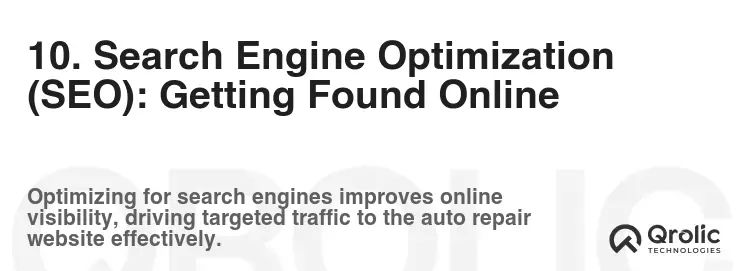
Climbing the Ranks: Mastering SEO Fundamentals
Search engine optimization (SEO) is the process of optimizing your website to rank higher in search engine results pages (SERPs). This is essential for attracting organic traffic to your website.
Key SEO Strategies for Auto Repair Shops:
- Keyword Research: Identify the keywords that your target audience is using to search for auto repair services.
- On-Page Optimization: Optimize your website’s content, including titles, headings, and body text, with relevant keywords.
- Technical SEO: Ensure that your website is technically sound and easy for search engines to crawl and index.
- Link Building: Build high-quality backlinks from other websites to improve your website’s authority.
- Local SEO: Optimize your website and online profiles for local search to attract customers in your area.
Local SEO Strategies:
- Google My Business: Claim and optimize your Google My Business listing.
- Online Directories: List your business in relevant online directories, such as Yelp and Yellow Pages.
- Local Citations: Ensure that your business name, address, and phone number (NAP) are consistent across all online platforms.
- Reviews: Encourage customers to leave reviews on Google and other review platforms.
Let Qrolic Technologies Help You Build the Perfect Website

Creating a website with all these essential features can seem daunting. That’s where Qrolic Technologies (https://qrolic.com/) comes in. We specialize in building high-performance websites that help auto repair shops like yours attract customers, build trust, and grow their businesses.
How Qrolic Technologies Can Help:
- Website Design and Development: We create custom websites that are visually appealing, mobile-friendly, and optimized for SEO.
- Online Scheduling Integration: We integrate online scheduling systems to streamline your booking process and improve customer convenience.
- SEO Services: We provide comprehensive SEO services to help your website rank higher in search engine results.
- Content Marketing: We create engaging content, including blog posts and videos, to attract and educate your audience.
- Website Maintenance and Support: We provide ongoing website maintenance and support to ensure that your website is always up-to-date and secure.
Why Choose Qrolic Technologies?
- Industry Expertise: We have extensive experience working with auto repair shops and understand their unique needs.
- Custom Solutions: We tailor our solutions to meet your specific business goals and budget.
- Proven Results: We have a track record of delivering measurable results for our clients.
- Dedicated Support: We provide dedicated support to ensure that you are always satisfied with our services.
Don’t let your website hold your business back. Contact Qrolic Technologies today to learn how we can help you create a website that works for you!
By incorporating these essential website features, your auto repair shop can thrive in the digital age, attracting new customers, building lasting relationships, and driving business growth. Your website is your digital storefront – make sure it represents your business in the best possible light.
